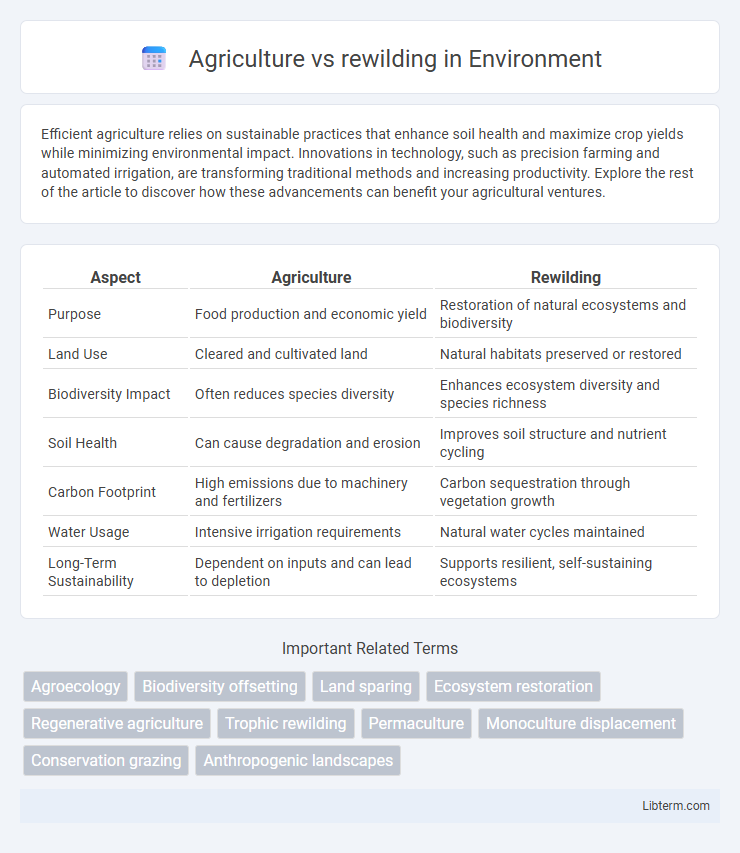Efficient agriculture relies on sustainable practices that enhance soil health and maximize crop yields while minimizing environmental impact. Innovations in technology, such as precision farming and automated irrigation, are transforming traditional methods and increasing productivity. Explore the rest of the article to discover how these advancements can benefit your agricultural ventures.
Table of Comparison
| Aspect | Agriculture | Rewilding |
|---|---|---|
| Purpose | Food production and economic yield | Restoration of natural ecosystems and biodiversity |
| Land Use | Cleared and cultivated land | Natural habitats preserved or restored |
| Biodiversity Impact | Often reduces species diversity | Enhances ecosystem diversity and species richness |
| Soil Health | Can cause degradation and erosion | Improves soil structure and nutrient cycling |
| Carbon Footprint | High emissions due to machinery and fertilizers | Carbon sequestration through vegetation growth |
| Water Usage | Intensive irrigation requirements | Natural water cycles maintained |
| Long-Term Sustainability | Dependent on inputs and can lead to depletion | Supports resilient, self-sustaining ecosystems |
Understanding Agriculture and Rewilding
Agriculture involves the systematic cultivation of crops and domestication of animals to produce food, fiber, and other resources, relying heavily on soil management, irrigation, and fertilization techniques for higher yields. Rewilding aims to restore natural ecosystems by reintroducing native species, promoting biodiversity, and allowing ecological processes to function without intensive human intervention. Understanding both approaches requires evaluating their impacts on biodiversity, carbon sequestration, and sustainability in landscapes shaped by human activity versus natural regeneration.
Historical Context: From Farming to Rewilding
Agriculture originated around 10,000 years ago during the Neolithic Revolution, transforming human societies from nomadic hunter-gatherers to settled farmers cultivating crops and domesticating animals. This shift led to significant landscape changes, including deforestation and soil modification, supporting population growth but reducing biodiversity. Rewilding seeks to restore these altered ecosystems by reintroducing native species and natural processes to reverse agricultural impacts and enhance ecological resilience.
Environmental Impacts: Agriculture vs Rewilding
Agriculture often leads to soil degradation, biodiversity loss, and increased greenhouse gas emissions due to intensive land use and chemical inputs. Rewilding promotes ecosystem restoration by allowing native flora and fauna to recover, enhancing carbon sequestration and improving soil health. Studies show rewilded areas can store up to 30% more carbon compared to conventional agricultural lands.
Biodiversity Outcomes in Both Approaches
Agriculture often reduces biodiversity by simplifying habitats and favoring monocultures, whereas rewilding actively restores native ecosystems, promoting diverse species populations and ecological functions. Studies show that rewilded areas support higher species richness, including pollinators, soil microbes, and large fauna, contributing to ecosystem resilience. While sustainable farming techniques can mitigate biodiversity loss, rewilding offers more substantial gains in restoring complex trophic interactions and natural habitat connectivity.
Contributions to Climate Change Mitigation
Agriculture significantly contributes to climate change through greenhouse gas emissions from livestock, deforestation, and soil degradation, releasing methane, nitrous oxide, and carbon dioxide. Rewilding enhances carbon sequestration by restoring natural ecosystems such as forests, wetlands, and grasslands, which capture and store vast amounts of atmospheric CO2. The transition from intensive agriculture to rewilding can reduce carbon footprints, increase biodiversity, and improve ecosystem resilience against climate impacts.
Food Security: The Agriculture-Rewilding Balance
Balancing agriculture with rewilding is crucial for long-term food security, as sustainable farming techniques can enhance soil health and biodiversity while maintaining crop yields. Rewilding contributes to natural pest control, water retention, and pollination, which support agricultural productivity without heavy reliance on chemical inputs. Integrating rewilded areas within agricultural landscapes promotes ecosystem services that stabilize food systems and increase resilience to climate change.
Economic Perspectives and Rural Livelihoods
Agriculture remains a primary driver of rural economies, providing jobs and sustaining local livelihoods through crop production and livestock farming. Rewilding offers potential economic benefits by promoting eco-tourism, enhancing biodiversity, and restoring ecosystem services that support sustainable agricultural practices. Balancing these approaches can create diversified income streams for rural communities while preserving environmental health and economic resilience.
Policy and Land Management Strategies
Agricultural policies often prioritize maximizing crop yields and food production through intensive land use, while rewilding emphasizes restoring natural ecosystems and biodiversity by reducing human intervention. Land management strategies for agriculture typically involve soil tillage, monoculture planting, and chemical inputs, contrasting with rewilding approaches that promote native vegetation, wildlife corridors, and ecological succession. Balancing these strategies requires integrated policy frameworks that incentivize conservation practices, sustainable farming, and habitat restoration to achieve both food security and environmental resilience.
Public Perception and Community Involvement
Public perception of agriculture often centers on food production and economic stability, while rewilding is increasingly seen as a vital strategy for biodiversity restoration and climate resilience. Community involvement in agriculture typically involves local farmers and stakeholders focused on sustainable practices, whereas rewilding projects engage broader segments of the public through education and volunteer opportunities. Effective collaboration between both sectors enhances ecosystem health and supports diverse community interests.
Future Directions: Integrating Agriculture and Rewilding
Future directions in integrating agriculture and rewilding emphasize regenerative farming techniques that promote biodiversity and soil health concurrently with crop production. Agroforestry, permaculture, and conservation agriculture serve as scalable models that balance food security with ecosystem restoration goals. Harnessing precision agriculture technologies and ecological monitoring enables adaptive management strategies to optimize both agricultural productivity and habitat regeneration.
Agriculture Infographic

 libterm.com
libterm.com